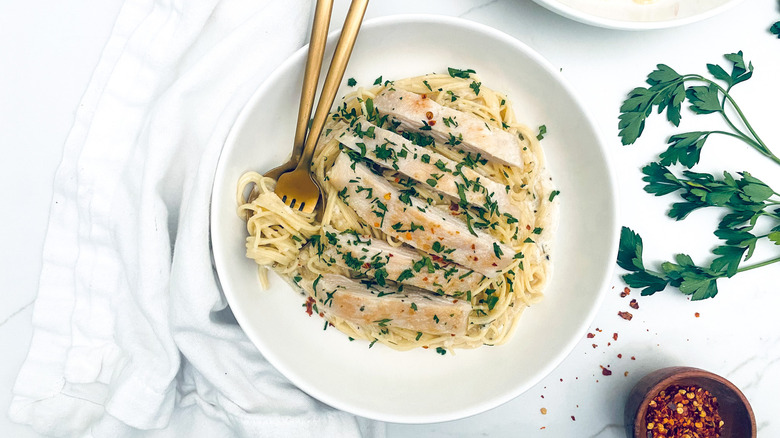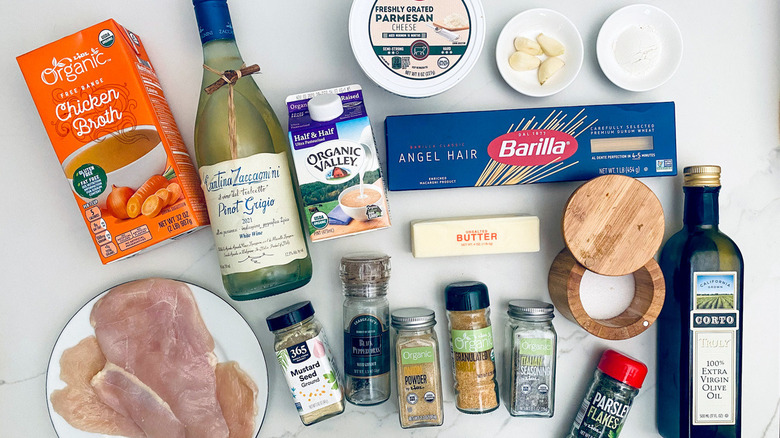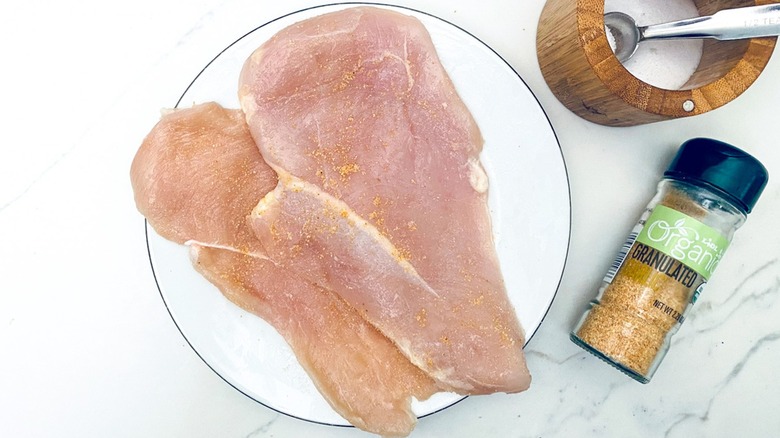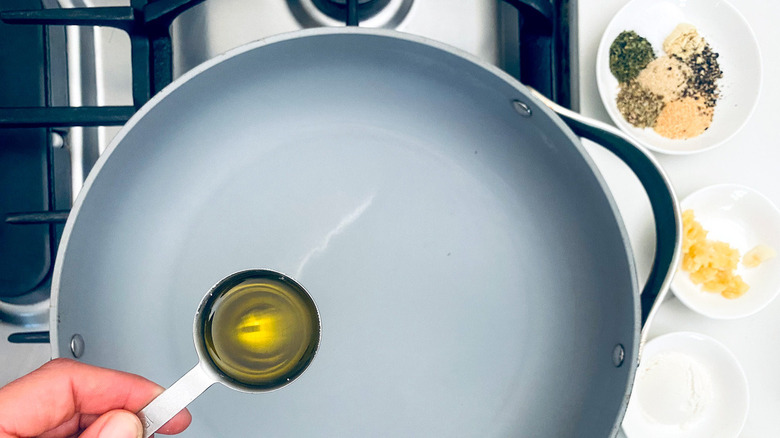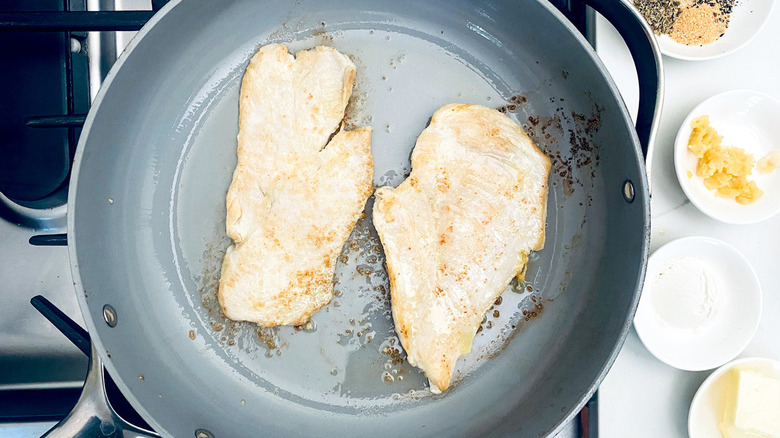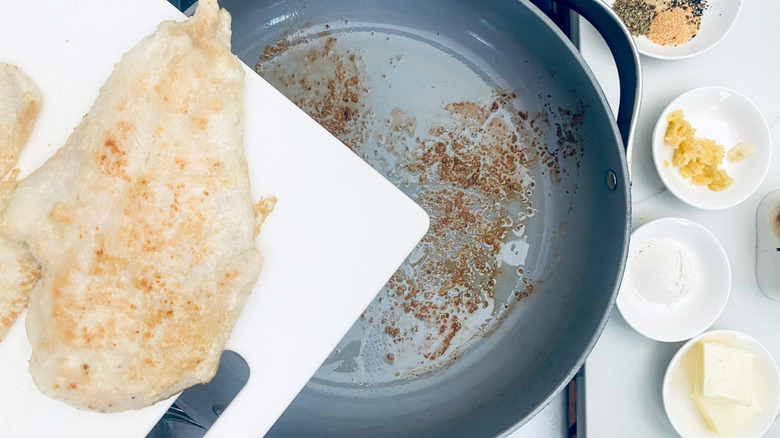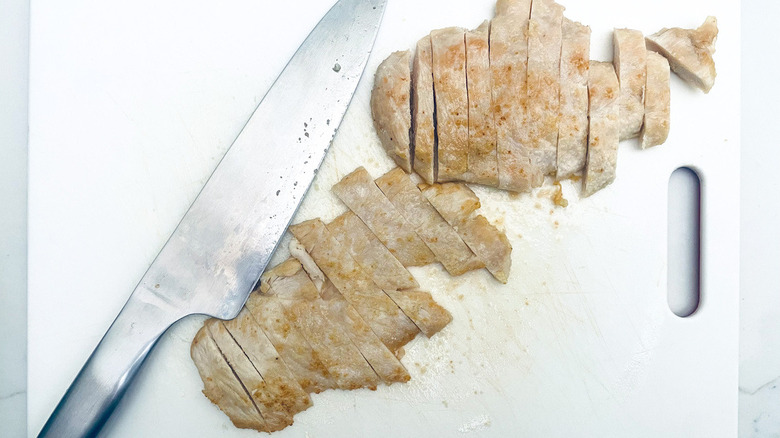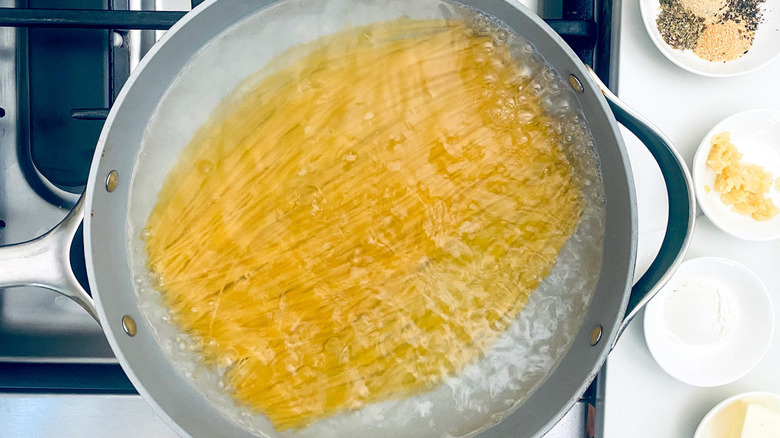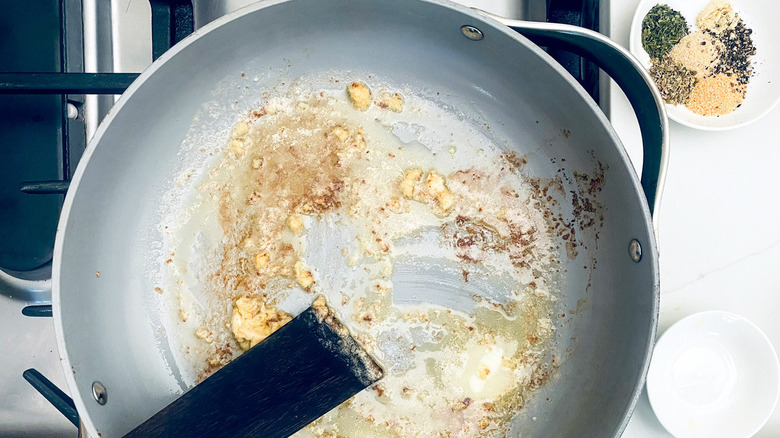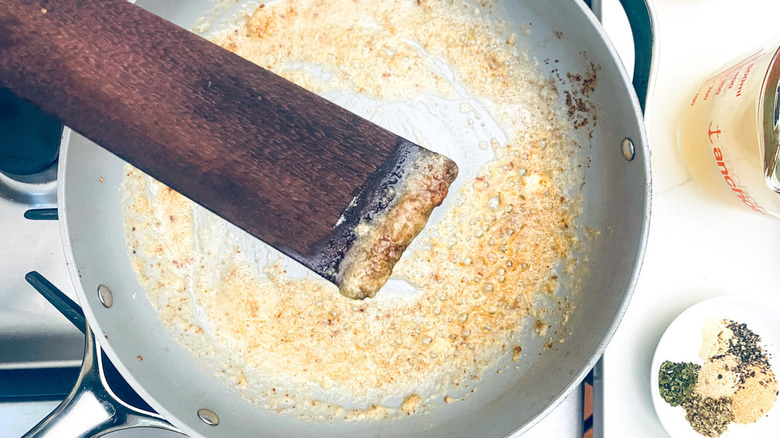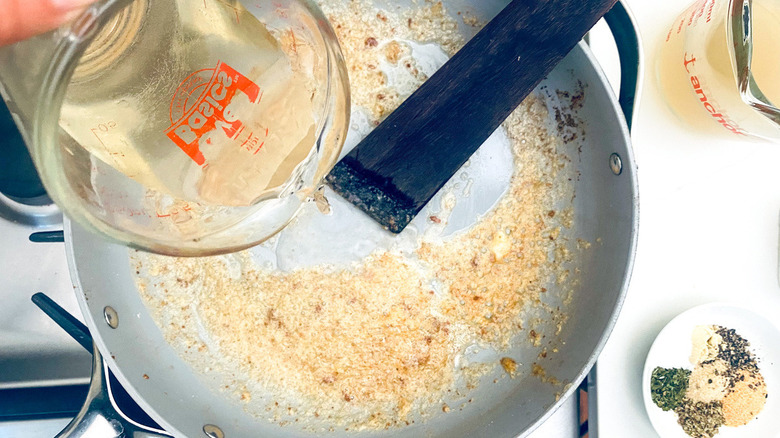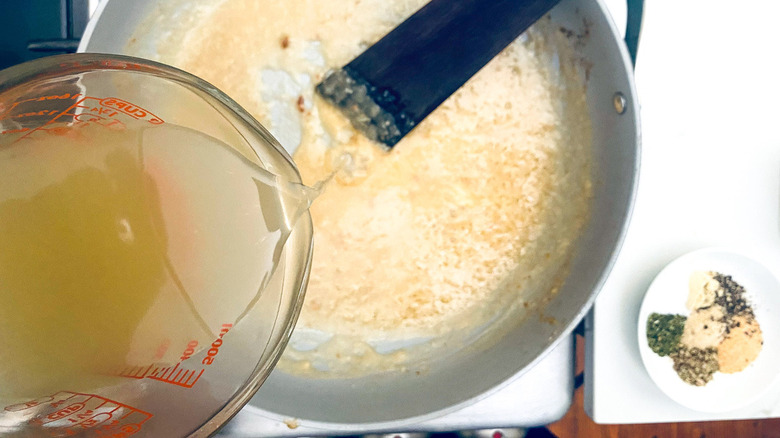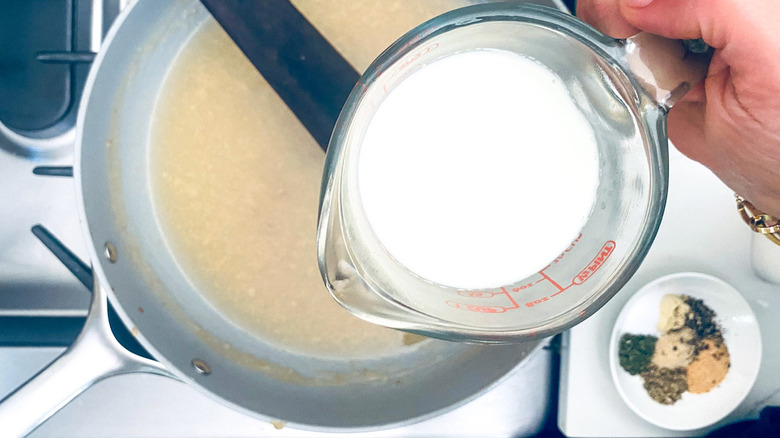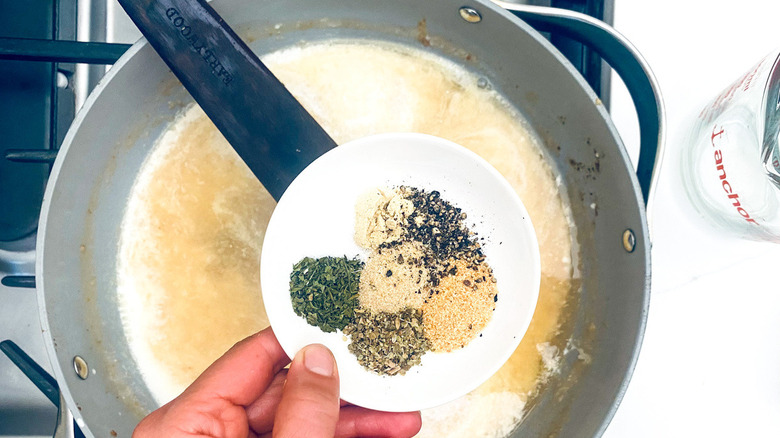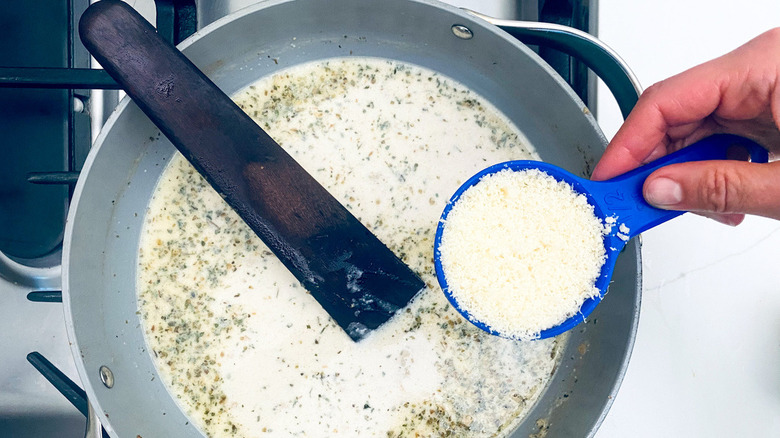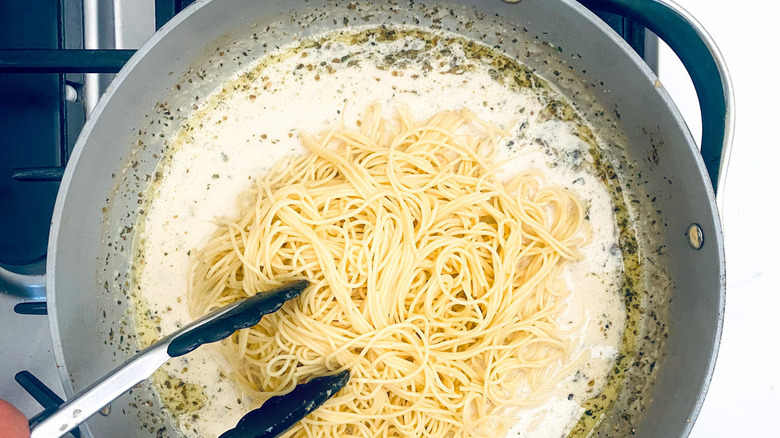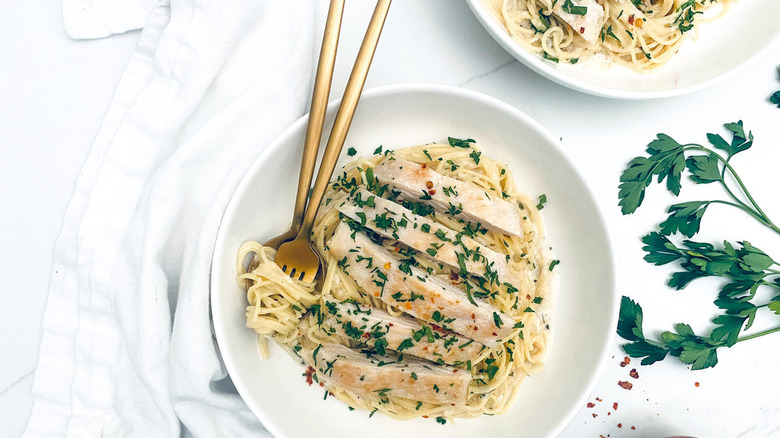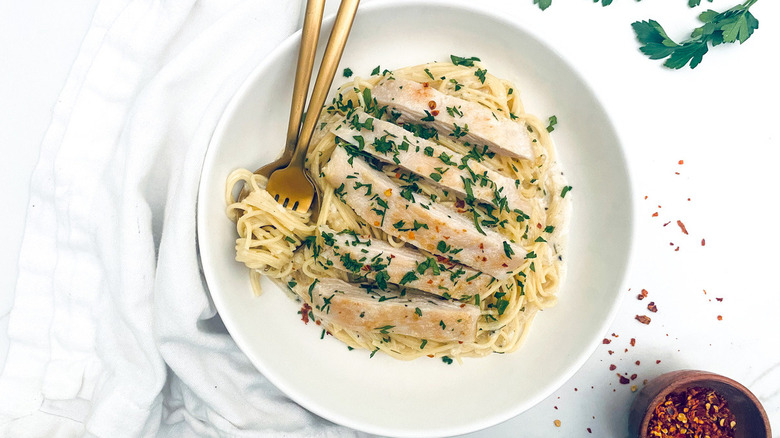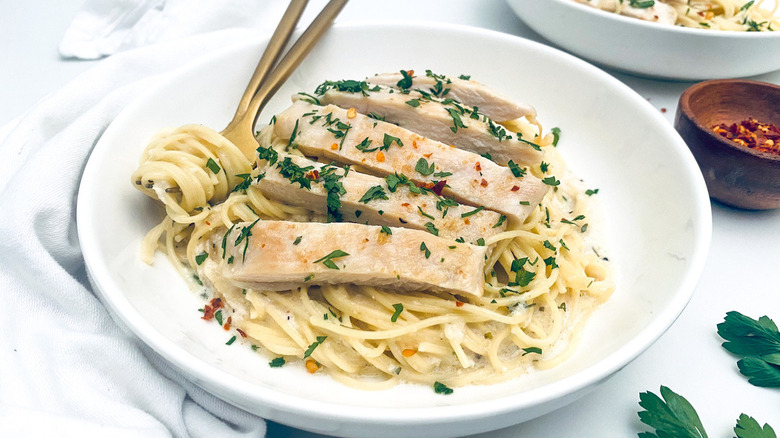Elevated Angel Chicken Pasta Recipe
Angel chicken is a food blogger favorite — a recipe that can be cooked in the slow cooker, oven, or on the stovetop and generally consists of chicken plus angel hair pasta (hence the name) in a creamy white sauce with Italian-inspired seasonings. Recipe developer Deniz Vergara says many recipes for the dish tend to be "made with a can of cream of chicken soup and a packet of Italian dressing mix," but, as she tells us, "I wanted to make this more elevated."
In order to turn this simple stovetop dish into something a bit fancier, Vergara says she makes it "all from scratch." This means that instead of using canned condensed soup, she makes her white sauce with butter, half-and-half, white wine, Parmesan cheese, and chicken stock, plus "tons of Italian seasonings." Her recipe also includes one ingredient not typically associated with Italian-American food: a pinch of mustard powder that adds a little pungency to the rich dish.
Assemble the ingredients for this elevated angel chicken pasta
For the chicken part of this dish, you'll need boneless, skinless breasts, plus salt, garlic powder, and olive oil. For the pasta, grab some angel hair spaghetti, butter, garlic, flour, white wine, chicken broth, half-and-half, parsley, mustard powder, Italian seasoning, onion powder, pepper, and Parmesan.
Step 1: Season the chicken
Season chicken with salt and garlic powder.
Step 2: Prep the skillet
Heat olive oil in a large skillet over medium-high heat.
Step 3: Cook the chicken
Add the chicken and sear until a golden crust develops, 2-3 minutes per side.
Step 4: Rest the chicken
Remove chicken from heat and set aside to rest for 10 minutes.
Step 5: Chop the chicken
Once rested, cut into strips.
Step 6: Boil the pasta
Meanwhile, cook pasta 1 minute less than indicated on package instructions. Drain and set aside.
Step 7: Start the pasta sauce
Start the pasta sauce by adding the butter and garlic to the same pan used for the chicken over medium-low heat.
Step 8: Stir in the flour
Once the butter has melted, add the flour and stir continuously for about 2 minutes, until the flour has turned a light brown and the raw flour smell has cooked off.
Step 9: Pour in the wine
Add the wine and continue to cook over medium heat, stirring occasionally, until the mixture thickens.
Step 10: Pour in the broth
Slowly add the chicken broth, stirring continuously.
Step 11: Stir in the half-and-half
Slowly stream in the half-and-half, and stir.
Step 12: Season the sauce
Add the parsley, mustard powder, Italian seasoning, onion powder, garlic powder, salt, and pepper, and stir to combine.
Step 13: Stir in the cheese
Reduce heat to low and add the Parmesan, stirring until fully incorporated.
Step 14: Toss the pasta in the sauce
Add the cooked pasta to the sauce, gently tossing with kitchen tongs to incorporate.
Step 15: Serve
Garnish with fresh parsley, if desired, and serve immediately.
How should I serve elevated angel chicken pasta?
This angel chicken pasta takes just over half an hour to prepare, making it "a quick and easy weeknight meal," per Vergara. "I would typically serve this during cooler weather since it is rich and creamy," she adds. Still, it could work as a warm-weather meal as well, since it doesn't involve the oven and won't heat up the house too much.
As for potential sides, Vergara says, "I like to serve this with roasted broccoli or a green salad," explaining that these foods may help to offset the richness of the sauce. Other non-starchy vegetables could also complement this pasta dish, particularly if dressed with a tangy vinaigrette. Acidic beverages, too, work well to accompany the meal. One obvious pairing for those who drink alcohol involves repurposing the leftover cooking wine as drinking wine, but for those who prefer a zero-proof drink, Vergara suggests "seltzer with a squeeze of lemon juice."
What can I do with leftover elevated angel chicken pasta?
Vergara notes that the leftovers of this chicken pasta dish can be kept in the refrigerator for 4 days and recommends sealing them in an airtight container. While "you can absolutely store the chicken and pasta together," she says, you might want to separate these two elements of the dish if you plan to reuse them separately.
The chicken on its own is a very versatile ingredient. It can be used in a salad, either a green one or a mayonnaise-based chicken salad; it can be shredded and used to fill tacos, enchiladas, or egg rolls; or it can be tossed in chicken soup or chili. Casseroles and pot pies are also possibilities, since pretty much anything you'd do with leftover rotisserie chicken, you can do with this chicken, as well. Vergara points out that the pasta, too, has possibilities, suggesting, "You can also repurpose leftover pasta into a noodle stir-fry if you like." Another idea would be to use the leftover spaghetti in a frittata or even on a pizza.
Elevated Angel Chicken Pasta Recipe
While most angel chicken recipes are made with canned soup mix and seasoning packets, this from-scratch version is elevated and still very easy.
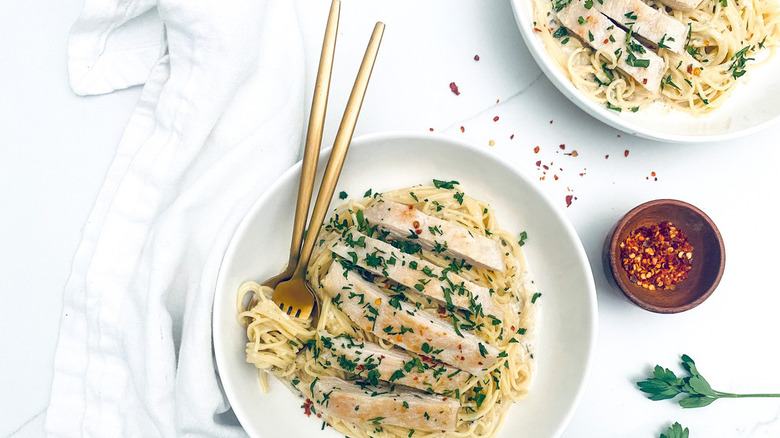
Ingredients
- For the chicken
- 8 ounces thinly sliced boneless skinless chicken breast
- ½ teaspoon sea salt
- ½ teaspoon garlic powder
- 1 tablespoon olive oil
- For the pasta and sauce
- ½ pound angel hair pasta
- 2 tablespoons butter
- 4 cloves garlic, minced
- 1 tablespoon all-purpose flour
- ½ cup dry white wine, such as Pinot Grigio
- 1 cup chicken broth
- ¾ cup half-and-half
- ½ teaspoon dried parsley
- ½ teaspoon mustard powder
- ½ teaspoon Italian seasoning
- ½ teaspoon onion powder
- ½ teaspoon garlic powder
- ½ teaspoon sea salt
- ¼ teaspoon black pepper
- ½ cup grated Parmesan cheese
Optional Ingredients
- Chopped fresh parsley, for garnish
Directions
- Season chicken with salt and garlic powder.
- Heat olive oil in a large skillet over medium-high heat.
- Add chicken and sear until a golden crust develops, 2-3 minutes per side.
- Remove chicken from heat and set aside to rest for 10 minutes.
- Once rested, cut into strips.
- Meanwhile, cook pasta 1 minute less than indicated on package instructions. Drain and set aside.
- Start the pasta sauce by adding the butter and garlic to the same pan used for the chicken over medium-low heat.
- Once the butter has melted, add the flour and stir continuously for about 2 minutes, until the flour has turned a light brown and the raw flour smell has cooked off.
- Add the wine and continue to cook over medium heat, stirring occasionally, until the mixture thickens.
- Slowly add the chicken broth, stirring continuously.
- Slowly stream in the half-and-half, and stir.
- Add the parsley, mustard powder, Italian seasoning, onion powder, garlic powder, salt, and pepper, and stir to combine.
- Reduce heat to low and add the Parmesan, stirring until fully incorporated.
- Add the cooked pasta to the sauce, gently tossing with kitchen tongs to incorporate.
- Garnish with fresh parsley, if desired, and serve immediately.
Nutrition
| Calories per Serving | 740 |
| Total Fat | 29.6 g |
| Saturated Fat | 14.2 g |
| Trans Fat | 0.3 g |
| Cholesterol | 116.0 mg |
| Total Carbohydrates | 68.3 g |
| Dietary Fiber | 2.9 g |
| Total Sugars | 5.9 g |
| Sodium | 879.9 mg |
| Protein | 40.6 g |
